Last Updated on January 17, 2024 by Greg Gillson
The bright red Northern Cardinals live year-round in woods and backyards. They do not migrate. They are found in the Eastern United States and the Southern and parts of the Southwestern United States. They barely reach the southeastern parts of Canada. They are found throughout much of Mexico and Central America.
Are there any cardinals where you live? If you are unsure, keep reading, because I list the locations in detail below. Then I tell about the particular habitats they like. If they live in your area, but don’t visit your backyard, I tell you what plants you can add to your landscaping to attract them.
This page is a supplement to my Overview of Northern Cardinal. The overview page leads to more in-depth pages about cardinals: what they look like, what they eat, where they nest. I’ll link back to that overview page again at the end of this article.
 |
| Northern Cardinal in the Northeastern U.S. Image by tlparadis from Pixabay |
Range and seasonal movements
Northern Cardinals are resident where they occur. They do not migrate but stay in the same area all year long.
There is some dispersal by the young-of-the-year into nearby areas. The range is slowly expanding northward into southernmost Canada.
In general, Northern Cardinals are resident from Guatemala and Belize north throughout nearly all of Mexico. Then they live from Arizona eastward in eastern half of North America to southern Canada. They live in the Northeast, Southeast, Midwest, and parts of the Southwest regions of the United States. More exact locations are listed below.
Where do Northern Cardinals live in summer and winter?
As mentioned, cardinals do not migrate. So they are found year-round wherever they occur. At the edge of their range single birds may show up every once in a while, perhaps almost every year, and stay around for a few months.
For the next lists of cardinals in different regions of the United States and Canada I have used data for the past 10 years from the website eBird.org.
Northern Cardinals in the Northeast United States
Northern Cardinals are very common in the Northeast. The only area where they are rare is in northern Maine. Otherwise, they are found throughout Vermont, New Hampshire, New York, Massachusetts, Connecticut, Rhode Island, New Jersey, and Pennsylvania.
Northern Cardinals live in…
- Connecticut
- Maine
- Massachusetts
- New Hampshire
- New Jersey
- New York
- Pennsylvania
- Rhode Island
- Vermont
Northern Cardinals in the Southeast United States
Northern Cardinals are common throughout the Southeast. They occur widely in Kentucky, West Virginia, Virginia, Delaware, Maryland, North Carolina, Tennessee, Arkansas, Louisiana, Mississippi, Alabama, Georgia, South Carolina, and Florida south to the Florida Keys.
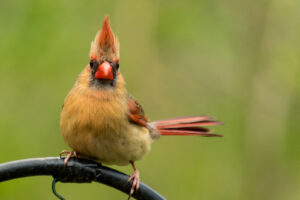
Northern Cardinals live in…
- Alabama
- Arkansas
- Delaware
- Florida
- Georgia
- Kentucky
- Louisiana
- Maryland
- Mississippi
- North Carolina
- South Carolina
- Tennessee
- Virginia
- West Virginia
Northern Cardinals in the Midwest United States
Northern Cardinals are found in Michigan and Wisconsin, increasing in abundance to the south.
In Minnesota the Northern Cardinal is pretty much absent in the boreal forest of the Northwoods, but increases until it is common in the southeast in the Twin Cities. Northern Cardinals are rather rare anywhere in North Dakota. Cardinals are found primarily in eastern South Dakota.
Cardinals are common and abundant in Iowa, Missouri, Illinois, Indiana, and Ohio.
Most cardinals in Nebraska are found in the eastern half of the state. Northern Cardinals are common in Kansas, more so in the eastern half.
Northern Cardinals live in…
- Illinois
- Indiana
- Iowa
- Kansas
- Michigan
- Minnesota
- Missouri
- Nebraska
- North Dakota
- Ohio
- Wisconsin
Northern Cardinals in the Rocky Mountains of the United States
Cardinals are very rare anywhere in this region, but may be found along the extreme eastern border of Colorado.
Northern Cardinals live in…
- Colorado
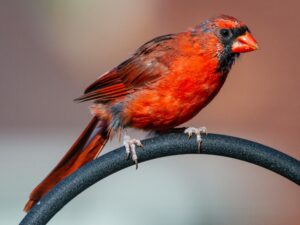
Northern Cardinals in the Southwest United States
Northern Cardinals are found widely in the central (Prescott), southern (Phoenix), and southeastern (Tucson) parts of Arizona. They are much less common in New Mexico, being found along the Gila River in the southwestern part of the state near Arizona and in the southeastern parts (Carlsbad) near Texas.
Northern Cardinals are common and widespread throughout Texas. In Oklahoma, cardinals are fairly common, but less common in the northwestern panhandle.
Northern Cardinals live in…
- Arizona
- New Mexico
- Oklahoma
- Texas
 |
| Northern Cardinal in Arizona desert Image by AZArtist from Pixabay |
Canada
Northern Cardinals are found in Nova Scotia, Prince Edward Island, and New Brunswick. They are found near Montreal in southern Quebec, and Toronto in southern Ontario. They are also found near Winnipeg in southern Manitoba. There are other scattered sightings in other areas of southern and southeastern Canada. However, most of the cardinals in Canada are in the large cities near the Great Lakes.
Northern Cardinals live in…
- Manitoba
- New Brunswick
- Nova Scotia
- Ontario
- Prine Edward Island
- Quebec
Subspecies
Currently there are 19 recognized subspecies of Northern Cardinals. They vary only very slightly in measurements and intensity of coloration. The differences are not of importance to most bird watchers.
Throughout most of the eastern United States is the nominate form, familiar to most people. There are two other forms in Texas. Another form is found in most of Florida. Several more forms, (also called subspecies) are found southward through Mexico to Belize and Guatemala.
The form found in Arizona has a taller crest, even larger bill, is brighter red, and has less black on the face. It is shown in the standard field guides for North America. [You can view the field guides on my Recommended Products page.]
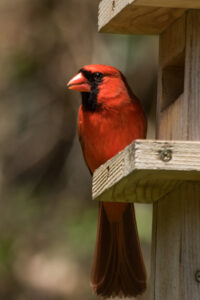
The ecology of Northern Cardinals
Northern Cardinal habitats in the eastern hardwood forests
Cardinals in the eastern United States live in the temperate deciduous biome (source). There are many divisions, as this is a large geographical area.
The dominant tree species are broad-leaved deciduous trees of about 30 different species. Two common trees in this biome include yellow buckeye, white basswood. They are found nearly throughout. Other common trees in this biome include American beech, sugar maple, and white oak. Dominant trees differ in the various divisions of the biome.
As for Northern Cardinals, they like all the forest types in the East. They are most common in habitats between woodland edges and grasslands. They need shrubs and thickets for nesting. They also like wooded streamside edges.
Pete Dunne, in his book Essential Field Guide Companion, emphasizes that the cardinal “thrives in suburbia” (emphasis his). Thus, you may look for cardinals in backyards and city parks.
Northern Cardinal habitats in the southwestern deserts.
Surprisingly, Northern Cardinals are also found in the Arizona deserts. These are a different subspecies. They are brighter red and have a taller crest. For other differences see above under “subspecies.”
But even though Phoenix, Arizona is so different from Columbus, Ohio, you may still find cardinals in backyards, gardens, and city parks in both states.
But then you may find Northern Cardinals in mesquite washes and desert river bottoms in Arizona. That’s quite a difference from the snowy winter woods of upstate New York, or the swamplands of the Florida Keys.
Backyard trees and plants to attract Northern Cardinals
To make your yard more attractive to cardinals, plant trees and shrubs with thick foliage. Some evergreens will provide shelter in winter when deciduous trees lose their leaves.
Grape, clematis, dogwood, sumac, mulberry, hawthorn, rose, and blueberries are all mentioned as attracting cardinals.
The good thing about planting trees and shrubs to attract Northern Cardinals is that cardinals often stay low to the ground. Thus, trees don’t have to be very tall before they are attractive to cardinals. The just need to provide thick shelter for the birds.
What niche does the Northern Cardinal fill?
Northern Cardinals feed on seeds, often on the ground under trees or bushes. So they may compete for seeds with sparrows. Their heavy bill will allow them to eat larger seeds with thicker shells than many sparrows.
Their preference for woodlands, though, is different from many sparrows that like more open areas. Cardinals also eat fruit, grain, and weed seeds. They feed insects to their nestlings.
Cardinals may help distribute the seeds of trees in their forest, thus helping the forest to survive and expand.
Because they may spend much time on or near the ground, cardinals may fall prey to housecats.
Return to the Overview page on Northern Cardinals
Wrapping Up
Northern Cardinals are so common that we often overlook them as uninteresting and a bit boring. Here are some facts about these stunning birds to make you change your mind:
The Northern Cardinal is a captivating bird, well-known for its vibrant red plumage and melodic song. But delve deeper, and you’ll discover even more fascinating facts about this beloved North American songbird:
Color Chameleon: While male cardinals boast a brilliant red coat, did you know it’s not actually due to pigment? Their feathers contain carotenoids, natural pigments found in their food (like seeds and fruits), which reflect red light. So, their diet directly influences their red intensity!
Singing Sweethearts: Both male and female cardinals sing! Females use their melodic tunes to communicate with their mates, often while incubating eggs or requesting food. This makes them one of the few North American songbirds where both sexes actively sing.
Lifelong Lovers: Northern cardinals are renowned for their strong pair bonds. In many cases, they mate for life, sharing parenting duties and defending their territory together. They even display affectionate behaviors like preening each other’s feathers, solidifying their close connection.
Winter Warriors: Unlike many migratory birds, cardinals are year-round residents in much of their range. Their thick layer of down feathers and adaptable diet allow them to thrive even in colder temperatures. In fact, their red plumage stands out even more against a snowy backdrop!
Yellow Oddities: While rare, a handful of Northern Cardinals exhibit a yellow plumage mutation. These “golden cardinals” are stunningly unusual, with their vibrant yellow replacing the typical red. Seeing one is a truly remarkable sight!
Cardinal Superstitions: Throughout history, many cultures have associated cardinals with positive symbolism. In some traditions, they signify good luck, love, or new beginnings. Seeing a cardinal is often interpreted as a message of hope and encouragement.
Bird Brainiacs: Studies suggest that cardinals possess remarkable cognitive abilities. They can learn complex songs, memorize routes, and even recognize individual humans over time. Their intelligence adds another layer of intrigue to these fascinating birds.
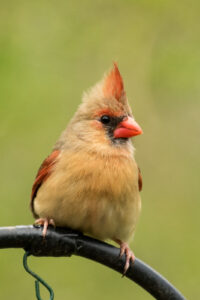
Frequently Asked Questions
What are nicknames for cardinals the bird?
Northern Cardinals, with their striking red plumage and beautiful songs, have inspired a variety of nicknames throughout history and across different cultures. Here are some of the most interesting and fun ones:
- Redbird: This straightforward nickname simply points to the bird’s most prominent feature.
- Cardinal Grosbeak: This scientific name is sometimes used as a nickname, especially by birdwatchers and naturalists.
- Top-knot Redbird: This nickname references the male cardinal’s characteristic crest of feathers.
- Virginia Nightingale: In some regions, especially the southeastern US, cardinals are called “Virginia Nightingales” for their melodious singing.
Why are cardinals called cardinals?
There are a few different theories about why cardinals are called cardinals, with the most likely explanation being a connection to the Catholic Church:
1. Color Connection: The vibrant red plumage of male cardinals bears a striking resemblance to the scarlet robes worn by high-ranking officials in the Catholic Church, known as cardinals. This visual similarity is the most widely accepted explanation for the bird’s name.
2. Roman Origins: Another theory suggests the name originated from the Latin word “cardinalis,” meaning “principal” or “eminent.” This could have been applied to the bird due to its prominent red appearance and strong presence in its habitat.
3. Historical Association: Cardinals were once called “redbirds” in North America. However, as settlers encountered scarlet tanagers, another red bird, differentiating them became necessary. Around the same time, cardinals were observed near Catholic missions, possibly leading to the adoption of the term “cardinal” to distinguish them from other red birds.
Why is the male Northern Cardinal so red?
The vibrant red hue of the male Northern Cardinal is a captivating feature, but the reason behind it isn’t simply pigment! Here’s the science behind their remarkable color:
Carotenoids, not pigments: Male Cardinals don’t actually have red feathers in the typical sense. Instead, their feathers contain microscopic structures that reflect red light waves. This stunning color comes from carotenoids, natural pigments found in the food they eat, like seeds, fruits, and insects.
Diet impacts their red intensity: The amount of carotenoids in their diet directly influences the red intensity of their feathers. Birds consuming more carotenoid-rich food will boast a deeper, richer red, while those with less intake might appear slightly orange or even paler.
Structural trickery: The red feathers themselves don’t contain red pigments; instead, they have microscopic structures that act like tiny mirrors, selectively reflecting red light waves and absorbing other colors. This optical phenomenon is responsible for the striking red shade we see.
Honest advertising: The red plumage of male cardinals serves multiple purposes. It acts as a signal of health and fitness, with brighter birds potentially attracting more mates and breeding successfully. It also plays a role in defending their territory and deterring rivals.
Red, not always red: Interestingly, not all Northern Cardinals are red! Occasionally, genetic mutations can result in yellow or orange variations. These “gold cardinals” are rare but stunningly beautiful, proving that even nature loves to surprise us with its diversity.






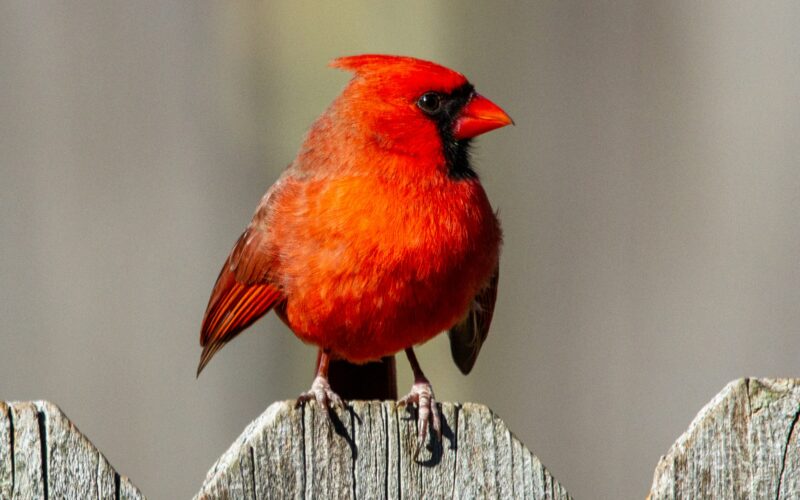
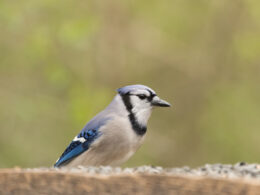
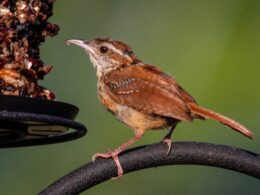

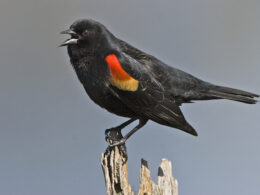
Great information. Thanks!